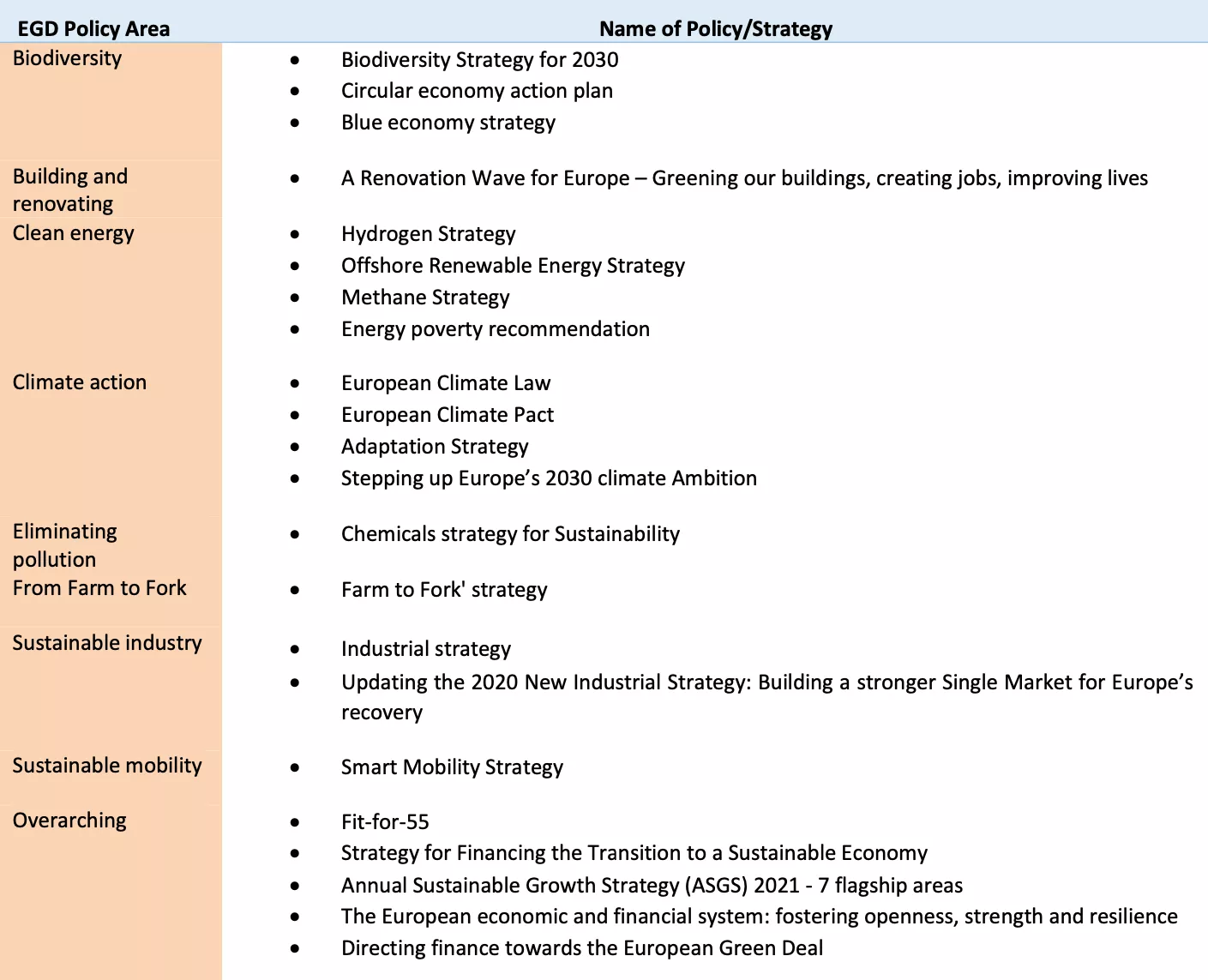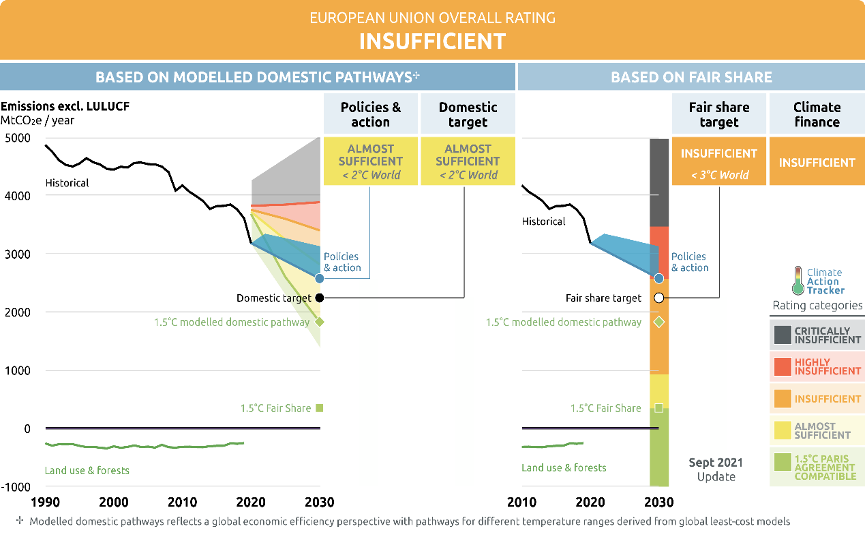5. Conclusions: Strategic Approaches for Europe’s Sustainability Transition
The Intergovernmental Panel on Climate Change, in its recently published reports (e.g. IPCC, 2021), has urged policymakers to act decisively to fight climate change because action at unprecedented scale and speed is required for global climate stabilization. Indeed, the European Union has taken significant steps toward climate change mitigation and adaptation in recent years, within a broader agenda encompassing the entire sustainability transition.
A critical component of the European Green Deal is the attempt to fully implement the EU’s emission reduction commitment under the Paris Agreement, supported by wide-ranging policy measures and very substantial financial resources. In June 2021, the European Climate Law was adopted, making both a revised 2030 (55% reduction in GHG emissions compared to 1990) and the aim of climate neutrality by 2050 legally binding. In July 2021, the European Commission unveiled its “Fit for 55” bundle of policy recommendations to achieve the new 2030 objective.
Sustainable development and action against climate change are at the heart of European political action. Starting from the ambitious goals of the European Green Deal and with a significant number of policies, strategies, and guidelines that support it, the European Commission puts its intentions into practice to make Europe a continent that is climate neutral, protects the environment and biodiversity, and addresses social challenges fairly, leaving no one behind.
In this 2nd Annual Report of SDSN Europe’s Senior Working Group, we focused on 22 policies, strategies and other texts published after the launch of the European Green Deal and assessed whether they are in line with the 17 SDGs. It is crucial that, except for Sustainable Agriculture, the 22 policies presented in Chapter 1 cover all other policy areas of the European Green Deal, such as Biodiversity, Building and renovation, Clean Energy, Climate Action, etc. This means that they set the framework for the transition to sustainability, climate neutrality and the development of just societies in Europe (Table 18).
Table 18 Mapping of Policies/Strategies to the European Green Deal Policy areas

With policies such as the New Circular Economic Action Plan and the Biodiversity Strategy for 2030, the European Commission helps the Economies shift from a Linear to a Circular production model, which plays a crucial role in drastically reducing greenhouse gas emissions. Second, policies such as the “Farm to Fork Strategy” on sustainable food support the provision of food for a growing population and restore the natural resources exploited. Third, the Climate law and Mobility Strategy promotes the use of renewable energy, the service of climate-neutral transportation, and the construction and improvement of energy-efficient buildings. Further, policy initiatives such as the Just Transition Fund and the Climate Pact facilitate the development of social inclusion by empowering minorities and contributing to regional and rural development.
The above Policies and Actions are tangible examples of the EU leadership’s willingness to adopt SDGs as Europe’s economic development framework. The fact that the Policies accompanying the European Green Deal support the implementation of the 17 SDGs sufficiently is the main conclusion of our analysis in Chapter 2, carried out both with manual textual analysis and through Machine Learning techniques.
At the same time, even this ambitious framework may fall short of the necessary global action to tackle the major sustainability challenges. For example, according to the Climate Action Tracker[1], the EU’s climate targets, policies, and finance are overall “Insufficient”. For “Policies & Action”, the Tracker’s assessment is that they are “Almost Sufficient” (as shown in Figure 40).

Figure 40 The CAT rates the EU’s climate targets, policies, and finance as “Insufficient”. Source: climateactiontracker.org
This rating implies that the EU’s climate policy still has potential for further development, particularly speeding up the coal phase-out, increasing funding for climate action abroad, and moving beyond the existing 55 per cent emissions reduction target by 2030.
Apart from enacting EU-level policies, implementation is crucial. Therefore, the EU must ensure that all Member States adopt climate policy measures because the action in individual countries has been inconsistent in the past. For example, although EU leaders adopted the ‘Next Generation EU’ recovery fund in 2021, with at least 37% of the budget dedicated to climate action, certain nations are pressing for EU funding to be spent on natural gas infrastructure development. The EU is currently revising the Trans-European Networks for Energy (TEN-E) Regulation[2], which defines which transboundary projects can be labelled as Projects of Common Interest and gain access to EU funds. As a result of this modification, the EU may continue to subsidize some natural gas infrastructure using public funds rather than focusing on zero-emission energy sources and intelligent energy solutions.
The global economy relies heavily on the financial sector to supply sufficient capital for the transition to sustainability. This explains why academic research and the finance industry are increasingly turning to Sustainable Finance, namely the concept of incorporating Environmental, Social, and Good Governance (ESG) criteria in all financial investment decisions.
Sustainable finance is critical to achieving the policy goals set out in the European Green Deal and the EU’s international climate and sustainability commitments. Very substantial amounts must be channeled through private investment for the transition to a climate-neutral, climate-resilient, resource-efficient, and fair European economy as a supplement to public funds. In addition, sustainable finance will ensure that investments promote a resilient economy and a long-term recovery from the COVID-19 pandemic.
In 2020, the Taxonomy Regulation (EU) 2020/852 on the Establishment of a Framework to Facilitate Sustainable Investments went into effect. For its full implementation, a rigorous classification system is required to precisely describe the requirements that sustainable or green investment products must meet. A taxonomy like this could help investors make informed judgments, avoid greenwashing, and channel cash into long-term projects. Moreover, the Sustainable Finance Disclosure Regulation (Regulation (EU) 2019/2088 (SFDR)) has considerably enhanced the legal framework for ESG-compatible financial products.
The financing needs are huge. As highlighted in several sections of Chapters 3 and 4 of this report, the envisaged transformation of the EU will require massive investments from both the public and private sectors to meet the SDGs. The €1 trillion estimated by the European Commission for the green transformation of the European economy to support the Green Deal is not enough. Although this is a substantial figure, at least another €2.5 trillion is needed mainly by the private sector; this requires a rigorous regulatory environment and appropriate incentives to support further ESG investments (Brühl V., 2021).
Almost all sectors of our economy, including but not limited to power generation and consumption, mobility, manufacturing, and agriculture, require a green transformation. Therefore, we need the private sector to succeed wholly committed to the sustainability shift. Moreover, to align demand with supply and ensure that sustainable products and services are both available and affordable, fiscal policies are crucial: Tax structures, subsidies and pricing will need to reflect the product’s total environmental and social costs, as outlined in Chapter 3 of the report.
Additional financial incentives to encourage green investments should be explored because of the apparent need to accelerate the implementation of the European Green Deal. Several aspects of this necessary transition have been discussed in our report and will be the main subject of further elaboration in the work of this Senior Working Group in the coming years.